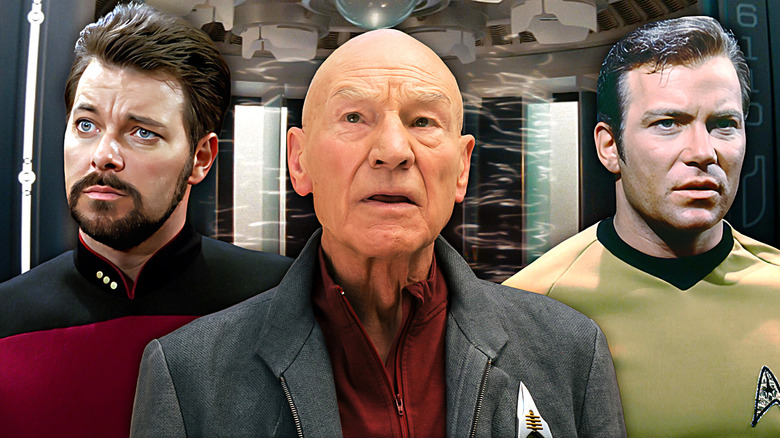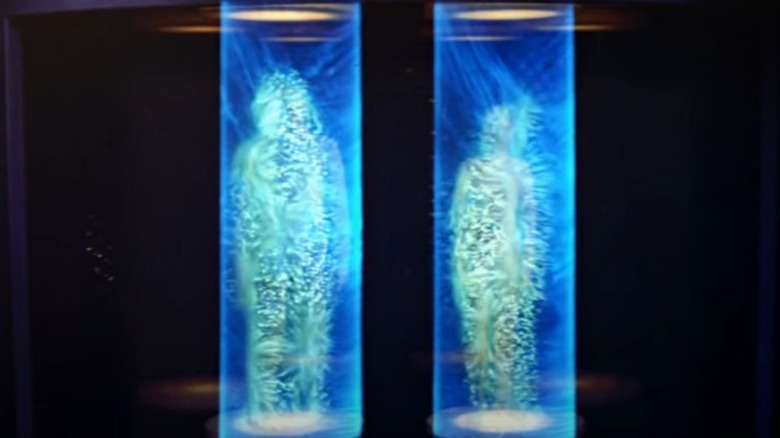How Star Trek Transporters Actually Work & Why They Are So Scary
Is there a more handy way to travel than a "Star Trek" transporter? Just step onto the platform with some sidekicks and a couple of convenient redshirts, tell Scotty (James Doohan) or a series-appropriate equivalent to beam you up, and whoosh — you're at the intended destination.
That's how the various "Star Trek" shows present it, anyway. The truth behind transporter tech is far scarier. The device works by turning the person's mass into energy, quite literally beaming said energy to the intended destination, and then converting it back to mass. In other words, it disintegrates the people using it and then rebuilds them in a faraway location. This seems wildly unnerving when you really think about it, and some fans consider transporters to be outright killing-and-cloning devices, making them one of the most questionable things in the "Star Trek" franchise that fans simply ignore.
The prospect of James T. Kirk (William Shatner), Jean-Luc Picard (Patrick Stewart), and others potentially dying and getting replaced with a clone every time they visit an alien planet is a fairly chilling theory, at least if you ask the fans. "Do you really teleport a person from point A to point B, or do you destroy (i.e. kill) a person, and reassemble his molecules in another location into an exact copy of that person, who thinks he's that person? Think about that next time you watch an episode of Star Trek," u/OnlySane1 wrote on Reddit. "The problem is, you'll nether know, because the teleported person does not know if it is just a copy," u/FrozenHaystack shared. However, others, like u/catwhowalksbyhimself and u/IMrMacheteI, have noted that the transporter doesn't kill its user. In fact, some versions of the technology even allow the person to talk or move during the process.
Transporters can malfunction in many creepy ways
While the transporters' matter-conversion process might not routinely kill the transportee, the technology is still fairly unnerving. In fact, several characters find these machines extremely creepy. The in-universe term "transporter phobia" is used to describe people who are scared of transporter machines, and notable characters like Doctors Leonard McCoy (DeForest Kelley) and Katherine Pulaski (Diana Muldaur) have been very wary of using them.
They have good reason to be concerned, too. No matter how secure they are, transporters are still methods of transportation, which means there's going to be an occasional mishap ... and when this sort of technology causes problems, said problems can be extremely serious. The long list of transporter accidents various "Star Trek" characters may encounter includes arriving in the wrong place, time, or even universe. The machine could also de-age the transportees, malfunction in a way that leaves foreign objects embedded in their bodies, or, in an example of a time "Star Trek" went too far, even fatally mangle the poor users. Transporters have also been known to split people into two individuals and merge two different people into one. Early models can even induce a condition known as transporter psychosis – a vast array of untreatable physical and mental issues caused by the damage that transporting causes over time.
Yes, every mode of transport has its dangers. Still, your car is unlikely to leave you randomly stranded in an evil Mirror Universe, which is what happens in the "Star Trek: The Original Series" Season 2 episode "Mirror, Mirror." Even without the laundry list of other potential things that can go wrong with transporters, that alone is more than enough to make the technology a reliable source of legitimately horrifying "Star Trek" stories.

